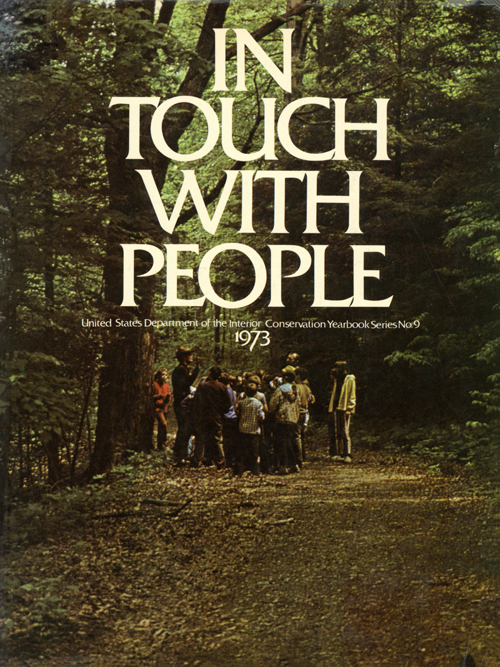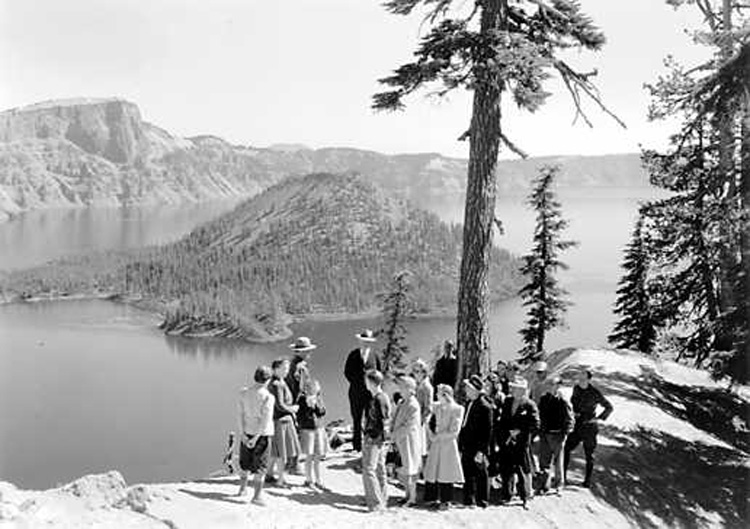

|
National Park Service History Electronic Library & Archive
The NPS History Electronic
Library & Archive is a portal to electronic publications covering the history of
the National Park Service (NPS) and the cultural and natural history of the national
parks, monuments, and historic sites of the (U.S.) National Park System. Also included
are documents for national monuments managed by other federal agencies, along with a
collection of U.S. Forest Service publications.
New eLibrary Additions
The Wilderness Act (September 3, 1964) The National Park Wilderness (Howard R. Stagner, 1957) Wilderness in the National Parks—Now More Than Ever (Jay Watson, extract from International Journal of Wilderness, Vol. 2 No. 1, May 1996) Wilderness Management in National Parks and Wildlife Refuges (Sandra B. Zellmer, May 2014) Wilderness in the National Park Service (Resource Brief) (June 23, 2023) The Path Not Taken (Richard West Sellars, extract from The George Wright Forum, v. 17, no. 4, 2000, ©The George Wright Society) Wilderness and Natural Resource Management in the NPS: Another View (Bob Krumenaker, extract from The George Wright Forum, v18 n1, 2001, ©The George Wright Society) Contributions to the Archaeology of Mammoth Cave and Vicinity, Kentucky (N.C. Nelson, Anthropological Papers of the American Museum of Natural History, Vol. XXII Part I, 1917) Discover One of Oregon's Historic Grand Lodges: The Chateau at the Oregon Caves National Monument & Preserve (Nicole Possert, extract from Field Notes, Summer 2024; ©Restore Oregon 20th Anniversary Celebration, Voyageur National Park (Elmer L. Andersen, August 25, 1991) Interpretation of Parks Through Use of Visual Aid Materials (H. Raymond Gregg extract from Parks and Recreation Magazine, May-June 1952) More than a Waterfall: The Story of White Oak Canyon Nature Trail, an Experiment in Nature Education (Bernard Frank and Ivan Tarnowaky, c1947) Cultural Landscape Report: West Potomac Park, Lincoln Memorial Grounds — Part 1 (August 1999) The 19th Coast Artillery and Fort Rosecrans: Remembrances (Howard B. Overton, comp. and ed., 1993) Historic Structures Report: Bluffs Lodge, Blue Ridge Parkway (Panamerican Consultants, Inc. and Wiss, Janney, Elstner Associates, Inc., August 2024) Ethnographic Guide to the Archaeology of Mt. Rainier National Park (Allan H. Smith, July 1964) The Mount Rainier National Park: Season of 1915 (1915) Mount Rainier National Park (1917) Forests of Mount Rainier National Park (G.F. Allen, 1916) The Ascent of Takhoma (Hazard Stevens, extract from The Atlantic Monthly, Vol. XXXVIII No. CCXXIX, November 1876) Circular of General Information Regarding Crater Lake National Park, Oregon (1930) Elbee Site (32ME408) and Karishta Site (32ME466), 2010 Archeological Test Excavations, Knife River Indian Villages National Historic Site, Mercer County, North Dakota (Dennis L. Toom and Michael A. Jackson, March 2012) Elbee Village Site (32ME408), 2003 Archeological Test Excavations, Knife River Indian Villages National Historic Site, Mercer County, North Dakota (Dennis L. Toom, Michael A. Jackson, Carrie F. Jackson, Zachary W. Wilson and Robert K. Nickel, October 2004) Historic Structure Report: Courtney Cabin, North Cascades National Park Service Complex, WA (Hennebery Eddy Architects and KPFF Consulting Engineers, April 2024) Rebuilding the Walls of Fort Jefferson (Craig M. Bennett, extract from Structure, Vol. 20 No. 5, May 2013) Cultural Landscape History for Fire Island National Seashore (Marstel-Day, Kristie Baynard, Kara Saffos and Paula Bienenfeld, 2022) Cultural Landscape Report for Liberty Island, Statue of Liberty National Monument (Lance Guerro, John Hammond, James Mealey, Julia Miller, Carlos Silva-Trejo, Aidan Ackerman, Meaghan Keefe, Elise Robinson and Anna Tiburzi, 2024) Cultural Landscape Report: Au Sable Light Station, Pictured Rocks National Lakeshore, Michigan (Quinn Evans, Land and Community Associates and Rachel Franklin Weekley, October 1998) Historic Structure Report: Grand Marais UCSG Life Saving Station, Pictured Rocks National Lakeshore (October 2020) Historic Structure Report: Rangers' Dormitory Building #21, Denali National Park and Preserve (Hennebery Eddy Architects, KPFF and Interface Engineering, Inc., May 2020) Into the Unknown: The Logistics Preparation of the Lewis and Clark Expedition (©Donald L. Carr, Master's Thesis U.S. Army Command and General Staff College, 2003) Ranger: The Journal of the Association of National Park Rangers (Vol 39 No 4, Fall 2023; ©Association of National Park Rangers) Park Science (Vol. 38 No. 1, Summer 2024) Natural Resource Condition Assessment, Lincoln Boyhood National Memorial NPS Natural Resource Report NPS/LIBO/NRR-2024/2617 (David S. Jones, Roy Cook, John Sovell, Matt Ley, Hannah Shepler, David Weinzimmer and Carlos Linares, January 2024) Status and Trends of Springs at Hovenweep National Monument, 1999-2021 NPS Natural Resource Report NPS/NCPN/NRR-2023/2560 (Rebecca Weissinger, August 2023) Men and Birds in Joint Occupation of National Parks (George M. Wright, May 6, 1934) The Vegetation and Carrying Capacity of the Ocracoke Pony Pen, Cape Hatteras National Seashore CPSU Technical Report 13 (Kathryn Davison, July 31, 1985) Horses on Ocracoke, Cape Hatteras National Seashore: An Information Review (Elaine F. Leslie and Kenet H. Redford, October 13, 2023) Modelling Effects of Flow Withdrawal Scenarios on Riverine and Riparian Features of the Yampa River in Dinosaur National Monument NPS Science Report NPS/SR-2024/178 (Rebecca M. Diehl and Jonathan M. Friedman, September 2024) Geologic Resources Inventory Report, Petersburg National Battlefield NPS Science Report NPS/SR-2024/190 (Trista L. Thornberry-Ehrlich, September 2024) Geologic Resources Inventory Report, Washita Battlefield National Historic Site NPS Science Report NPS/SR-2024/188 (Katie KellerLynn, September 2024) Landscape Phenology, Vegetation Condition, ,and Relations with Climate at Bryce Canyon National Park: 2000-2019 NPS Science Report NPS/SR-2024/189 (David Thoma, September 2024) From public lands to museums: The foundation of U.S. paleontology, the early history of federal lands and museums, and the developing role of the U.S. Department of the Interior (Gregory A. Liggett, S. Terry Childs, Nicholas A. Famoso, H. Gregory McDonald, Alan L. Titus, Elizabeth Varner and Cameron L. Liggett, extract from Museums at the Forefront of the History and Philosophy of Geology: History Made, History in the Making, Geological Society of America Special Paper 535, 2018, ©Geological Society of America) Cape Chronicle Newsletter (Cape Hatteras NS, Fort Raleigh NHS, Wright Brothers NMem) 2018: July 26 • August 2 • August 9 • August 15 • August 23 • August 30 • September 7 • September 20 • September 28 • October 4 • October 15 • October 26 • November 1 • November 8 • November 16 • November 21 • November 28 • December 13 2019: March 14 • March 21 • March 29 • April 5 • April 11 • April 19 • April 24 • May 2 • May 8 • May 15 • May 23 • May 30 • June 6 • June 12 • June 20 • July 3 • July 11 • July 18 • July 26 • August 1 • August 8 • August 15 • August 22 • August 29 • September 26 • October 4 • October 10 • October 23 • October 30 • December 5 2020: February 20 • March 3 • April 9 • April 15 • April 27 • May 22 • May 27 • June 11 • June 25 • July 9 • July 21 • August 20 • September 3 • September 10 • October 8 • October 15 • October 21 • November 5 • November 20 2021: March 3 • April 22 • April 29 • May 5 • May 13 • May 20 • May 27 • June • June • June 17 • June 28 • July 22 • August 6 • August 19 • August 26 • September 6 • September 15 • November 22 2022: February 11 • February 24 • March 21 • April 8 • April 11 • April 29 • May 5 • May 27 • June 30 • July 29 • August 25 • September 12 2023: January 11 • January 25 • January 30 • February 9 • February 23 • March 8 • March 23 • April 10 • April 25 • May 22 • June 13 • June 23 2024: April 30 • May 9 • May 23 • June 28 National Heritage Areas Program — A Year in Review: 2023 Statistical Abstract 2023 NPS Science Report NPS/SR-2024/139 (Pamela S. Ziesler and Claire M. Spalding, June 2024) FY 2022: Deferred Maintenance & Repair Infrastructure Fact Sheets (FY2022) Draft General Management Plan/Environmental Impact Statement, Grand Canyon National Park, Arizona (March 1995) General Plan: Chesapeake & Ohio Canal National Historical Park, District of Columbia/Maryland (John G. Parsons, January 30, 1976) Accessibility Assessment Summary of Findings and Recommendations, Acadia National Park (National Center on Accessibility Eppley Institute for Parks and Public Lands, December 2021) Accessibility Assessment Findings and Recommendations, Thomas Edison National Historical Park (National Center on Accessibility Eppley Institute for Parks and Public Lands, August 2021) Accessibility Assessment Findings and Recommendations, Lincoln Home National Historic Site (National Center on Accessibility Eppley Institute for Parks and Public Lands, January 2022) Accessibility Assessment Findings and Recommendations, Fort Donelson National Battlefield (National Center on Accessibility Eppley Institute for Parks and Public Lands, April 2022) Literature Review: Visitor Use Estimation for National Trails and National Wild and Scenic Rivers Systems (The Otak Team w/RRC Associates, September 2024) Socioeconomic Data Needs Assessment: Visitor Use Estimation for National Trails and National Wild and Scenic Rivers Systems (The Otak Team w/RRC Associates, September 2024) Proceedings of the Tacoma Academy of Science: Is it Mount Tacoma, or Rainier? (James Wickersham, 1893) Before the United States Geographic Board in the Matter of the Proposal to Change the Name of Mount Rainier (May 11, 1917) The Great Myth - "Mount Tacoma": Mount Rainier and the Facts of History (Olympia Chamber of Commerce, January 1924) The Name of Mount Tacoma (A.H. Denman, April 1924) "Mount Tacoma" vs. "Mount Rainier": The Fight to Rename the Mountain (Genevieve McCoy, extract from Pacific Northwest Quarterly, Vol. 77 No. 4, October 1986; all rights reserved) Mount Rainier or Mount Tacoma? (A.D. Martinson, extract from Columbia: The Magaine of Northwest History, Vol. 3 No. 2, Summer 1989; ©Washington State Historical Society)
A Guide to the National Parks of America (Edward Frank Allen, 1915) National Parks (American Civic Association, Series 11 No. 6, December 1912) President Taft on a National Parks Bureau (William Howard Taft) National Parks — The Need of the Future (James Bryce) The Need for a Bureau of National Parks (Walter L. Fisher) Are National Parks Worth While? (J. Horace McFarland) California and the Far West: Suggestions For The West Bound Traveler (K.E.M. Dumbell, 1914) The Pacific Coast Scenic Tour (Henry T. Finck, 1907) The Eleven Eaglets of the West (Paul Fountain, 1906) Recommendations of the Large Industrial Artifact Advisory Panel (February 1991) Reconnaissance Survey of Western Pennsylvania Roads and Sites (September 1985) Special History Study: The Evolution of Transportation in Western Pennsylvania (May 1994) A Legacy of Coal: The Coal Company Towns of Southwestern Pennsylvania Historic American Buildings Survey/Historic American Engineering Record America's Industrial Heritage Project (Margaret M. Mulrooney, 1989) Two Historic Pennsylvania Canal Towns: Alexandria and Saltsburg Historic American Buildings Survey/Historic American Engineering Record America's Industrial Heritage Project (Sara Amy Leach, ed., March 1989) Radio for the Fireline: A History of Electronic Communication in the Forest Service, 1905-1975 FS-369 (Gary Craven Gray, March 1982) A Cultural Resources Overview: Prehistory and Ethnography, Wenatchee National Forest (Jan L. Hollenbeck and Susan L. Carter, April 1986) Pacific Northwest Trail: A Report Based on a Joint Study by the Forest Service and National Park Service (June 1980) NPS Reflections
National Park Friends
| ||||||||||||||||||||||||||||||||
















